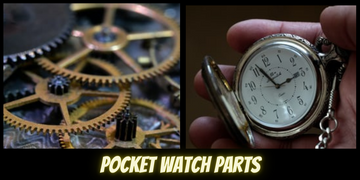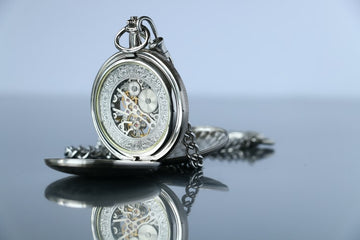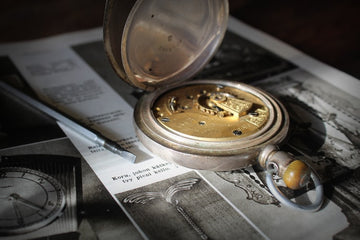
In the watch world, Pocket watches have been a vital part of contemporary evolution and developments. Thenceforward- the 16th century, they have been a fundamental part of the male-style. Do you know these elegant and retro-futuristic masterpieces may have different design attributes and appealing components, but they all be likely to share identical mechanical inner-workings? Suppose you have a pocket watch or are expecting to become a buyer. In that case, it is a virtuous notion to cram how pocket watch's parts relate to one another and how the elementary technicalities run predominantly as the older the timepieces are, the more probable it is to stop functioning or require inaccessible repair parts.
It is correspondingly significant to hassle that even if it may be alluring to excavate the back of a pocket watch to scrutinize its internal workings. As mentioned earlier, those can momentously lessen the clock's worth, specifically if it is a collector’s piece, and is most sufficient left to proficient watch-makers and menders.

POCKET WATCH DESIGN:
When it comes to the Pocket watches' design, they are apt to have a trivial, plane, spherical face that fits contentedly in the palm. Former designs may be elliptical or square, but in recent times the circle has subjugated. With the underlying elements of porcelain ware or metal, the watch surface will be sheathed in glass or a flawless crystal, with the nitty-gritty element.
The figures on the dial perchance both Roman or Arabic numbers and the facade will prospectively have an external ring of markers representing the seconds; however initial designs may not have this trademark and indeed may be omitted the second hand entirely. It is indeed not a ruthless thing; in reality, it replaces the watch's scarcity and perhaps specifies its higher worth!

POCKET WATCH INTERNALS:
Beneath the watch, the surface is the motorized element. Entirely pocket watches are run on a sequence of springs and wheels, often referred to as cogs and coils, with the mechanics-the wheels' running aids, keeping energy when twisted once every day. The rings procure the hands' elementary Drive and are associated with the watch stability, fundamentally a small pendulum that hangs onto the fixed time.
The inner mechanisms would be utterly mechanical in the primary pocket watches. Far along designs would see the Swiss design call into play. The inner workings are slicker and further precise with the usage of ornaments for tumbling abrasion and wear-however later, even now, would see the quartz crystal element eliminating the requirement for the wheel power.

UNDERSTANDING POCKET WATCH PARTS:
Can you visualize a car deprived of a steering wheel or stereo lacking speakers? That's what pocket watches are alike. They are imperfect without the understanding and familiarity of the parts they’re made up of. Most pocket watches are twisted whichever with a key-predominantly the antecedent models or with a button-occasionally recognized as a stem wind. Here are the parts which make pocket watches this noteworthy.
POCKET WATCH PARTS & TERMINOLOGY
Below are elements of the pocket watch we're curious about, so let's have a look:

· Acrylic Crystal
Have you ever thought what a crystal of watches is made up of? If you are still unaware of the constituents it comprises of; then you're at the right place. A crystal is a legal term used for the translucent lid of the dial accustomed to being fabricated from sapphire or glass, i.e., mineral crystal. Acrylic Crystals are prepared from vibrant synthetic plastics similar to Hesalite - these are unbreakable and have less intrinsic glower than glass and sapphire.
· Albert
Perhaps entitled after Prince Albert, this is a chain hooked up to the pocket watch, which fastens to a waistcoat boutonniere or collar buttonhole with a T-bar. A Double Albert has dualistic chains prolonging from the T-bar. An Albert is at times stated to as- a Fob; however, more precisely, a Fob is an adornment or rondure suspended from the chain in view and not in the pocket.
· Amplitude
The distance between the mid-point to the one end of the Balance Wheel is called its amplitude. Most of the watches have an amplitude between 270 and 320 degrees. The term is also used for the speed of the Balance Wheel.
· Anchor:
The Anchor manages the Escape Wheel measure to any cogwheel on each occasion, swaying crosswise-that's the clacking sound!!!!!
· Arbor:
The pinion or wheel, the shaft on a gear
· Balance Wheel
The wheel of the watch that rotates hither and thither rapidly is the moving portion of the pocket watch. Through the Hairspring, the balance wheel stems its push.
· Belt Chain
A substitute to an Albert.
· Bezel
To hold a crystal in site, a metal ring is used, which is known as Bezel. Typically it is attached or sheared on top of the frame of the timepiece.
· Blue Screws
These are the screws used as decoration material in the watch. They do not possess any practical use in the clock. Whichever by heat treatment or electrical anodizing that are stained blue - the same color as gunmetal.
· Bow
A hoop or metal ring at the uppermost of the Stem round the Crown cast-off to Albert to the timepiece or pin a chain.
· Bridge
Contingent to function, a watch appliance can be distributed into 2 or 3 poles apart segments. They are termed as Bridges.
· Case
The metallic portion of the timepiece that holds the Drive.
· Chapter Ring
This is the ring that indicates the hours and minutes, thus baptized as Chapter Ring.
· Crown
The grip designed for meandering and regulating stint at the topmost of the winding stem and occasionally known as the Crown.
· Damascening or Damaskeening (USA)
It is an American word used to intricate, sumptuous carving on the pocket watch drive; however, the design is gash through an upper coated surface of a changed colored metal.
· Dial
The timepiece face typically marked with digits (or indices. batons & bars) to divide the 360 degrees into hours and minutes.
· Ebauche
The elementary Drive frequently obtained via a watch manufacturer as of an external maker and then inflated and trademarked.
· Escape Wheel
A jagged wheel of which the teeth off and on involve and extricate with the Anchor.
· Escapement
It interprets the power in the Driving force to timekeeping.
· Frequency
The Balance Wheel often ranges the terminal of a revolution- one vibration to and fro equivalent to 2.

· Gear Train / Wheel Train
The sequence of Wheels and Pinions
· Guilloche
An ornamental method is used repetitively on Dials and Cases.
· Hairspring
The fine metallic coil hooked up with the Balance Wheel is called the Hairspring. It puts on a similar part as a pendulum in a wall clock.
· Hunter Case
To shelter the Crystal and Dial, a hunter case watch have a front cover.
· Incabloc
This is a spring-loaded intensifying method for the Ornaments on the Balance Wheel, Evident on skeleton watches.
· Indices or Index
The marking on a dial to break up the degrees into hours and minutes.
· Jewels
Jewels are used to reduce resistance and consequently upsurge the precision and lifespan of the timepiece.
· Luminova
In the darkness or low light, a blooming phosphorescent color cast-off creates the marks on a watch dial to make it clear.
· Mainspring & Mainspring Barrel
The chunkier spring in the watch.
· Moonphase
An orifice presenting a dial representing the segment of the moon.
· Movement
The elementary mechanisms or system, if the case is taken away, the only left is the watch's Movement, either it remains motorized or quartz.
· Mineral Crystal
A translucent glass casing of the watch dial.
· Open Dial
A pocket watches devoid of any cover or metallic cover to the Dial and Rock crystal.
· Pinion
Slighter gears present in the Movement
· Power Reserve
This is the expanse of time the timepiece can run once wholly coiled.
· Quartz Movement
A minute and low in cost substitute to a mechanical movement.
· Register
A sub-dial on the main dial
· Regulator
For the adjustment of the speed or frequency of the balance wheel, a Regulator is used.
· Repeater
A watch part that clangs the hours and quarters.
· Sapphire Crystal
A crystal clear and very stiff human-made form of sapphire, casted-off as a watch glass or Crystal.
· Second Time Zone
The time in a changed time zone is displayed by an extra Register dial called Second Time Zone.
· Sidewinder
A pocket watch where the Stem appears from the watch at 3:00 instead of at 12:00.
· Skeleton Watch
A watch whose Movement is on the display.
· Stem
With the Crown on the topmost, this is the shaft that poles out of the pocket watch.
· Sub-Dial
An additional term used for a Register
· Tourbillon
Helping to uphold the accuracy, a Tourbillon pledges the upshots of deviations in the timepiece's angle/position.
· Tritium
A self-driven light source is used to mark the patterns on a timepiece dial readable in the darkness.
· Wheel
The more giant gears in a fob watch that are frequently spooked.
- Winder
Alternative title used for the Crown.
Conclusion
A virtuous pocket watch is an inheritance to retain and treasure. Hang onto your pocket, watches functioning, and in good overhaul with eminence chronometrical parts. The Smithsonian Institution in their magazine has even termed the pocket watch as the
“World’s First Wearable Tech Game Changer.”
To buy more attractive designs and models, visit our store.
References:
- POCKET WATCH ELEMENTS. (n.d.). Retrieved November 25, 2020, from https://www.pocketwatch.co.uk/pocket-watch-elements-i143
- About the Author: Denis Carignan About Carignan Watch Repair CompanyCarignan Watch Company was officially started in January 1996. However, & About Carignan Watch Repair CompanyCarignan Watch Company was officially started in January 1996. However. (2019, September 14). Understanding Pocket Watch Parts: Carginan Watch Company. Retrieved November 26, 2020, from https://cwrnh.com/pocket-watch-nomenclature/
- History of Timepieces An Overview of Pocket Watches. (n.d.). Retrieved November 26, 2020, from https://www.govbergwatches.com/blog/overview-of-pocket-watches/
Pocket Watch for Sale


